Fraud Detection Report: Data Security on Social Media Platforms
VerifiedAdded on 2022/09/15
|6
|1113
|20
Report
AI Summary
This report provides an analysis of fraud detection and data security on social media platforms. It examines the methods employed by businesses, including locking hard copy files, encryption, and restricting data access, to protect user information. The report also emphasizes the role of users in securing their data through proper privacy settings. The discussion highlights the responsibilities of both consumers and social networking websites in safeguarding data against fraud, money laundering, and other illicit activities, mentioning the importance of GDPR compliance. The conclusion emphasizes the need for businesses to use security measures and the role of encryption and access restrictions while users are encouraged to limit the sharing of sensitive data to prevent unauthorized access and potential harm. The report references several academic papers to support its claims.
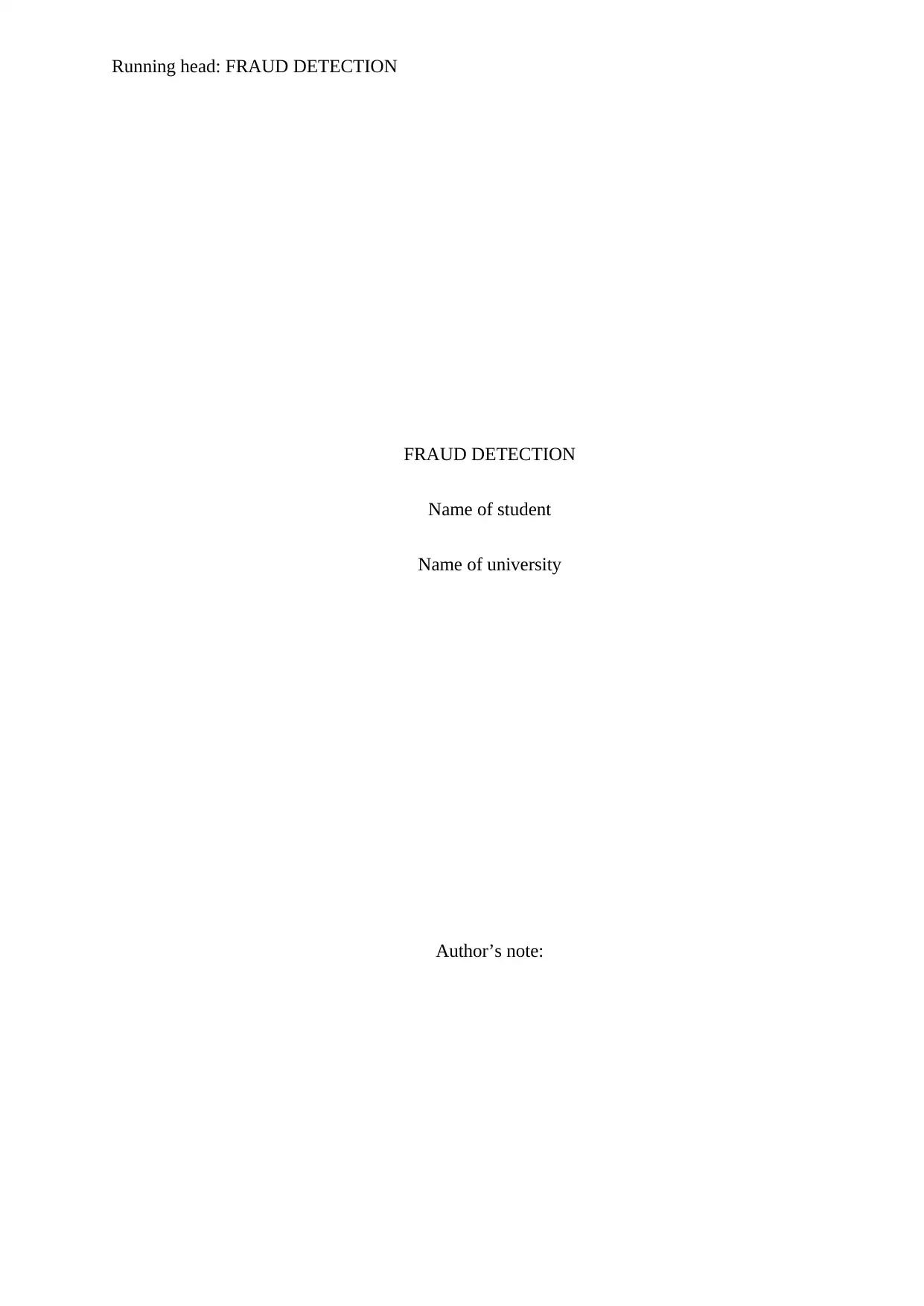
Running head: FRAUD DETECTION
FRAUD DETECTION
Name of student
Name of university
Author’s note:
FRAUD DETECTION
Name of student
Name of university
Author’s note:
Paraphrase This Document
Need a fresh take? Get an instant paraphrase of this document with our AI Paraphraser
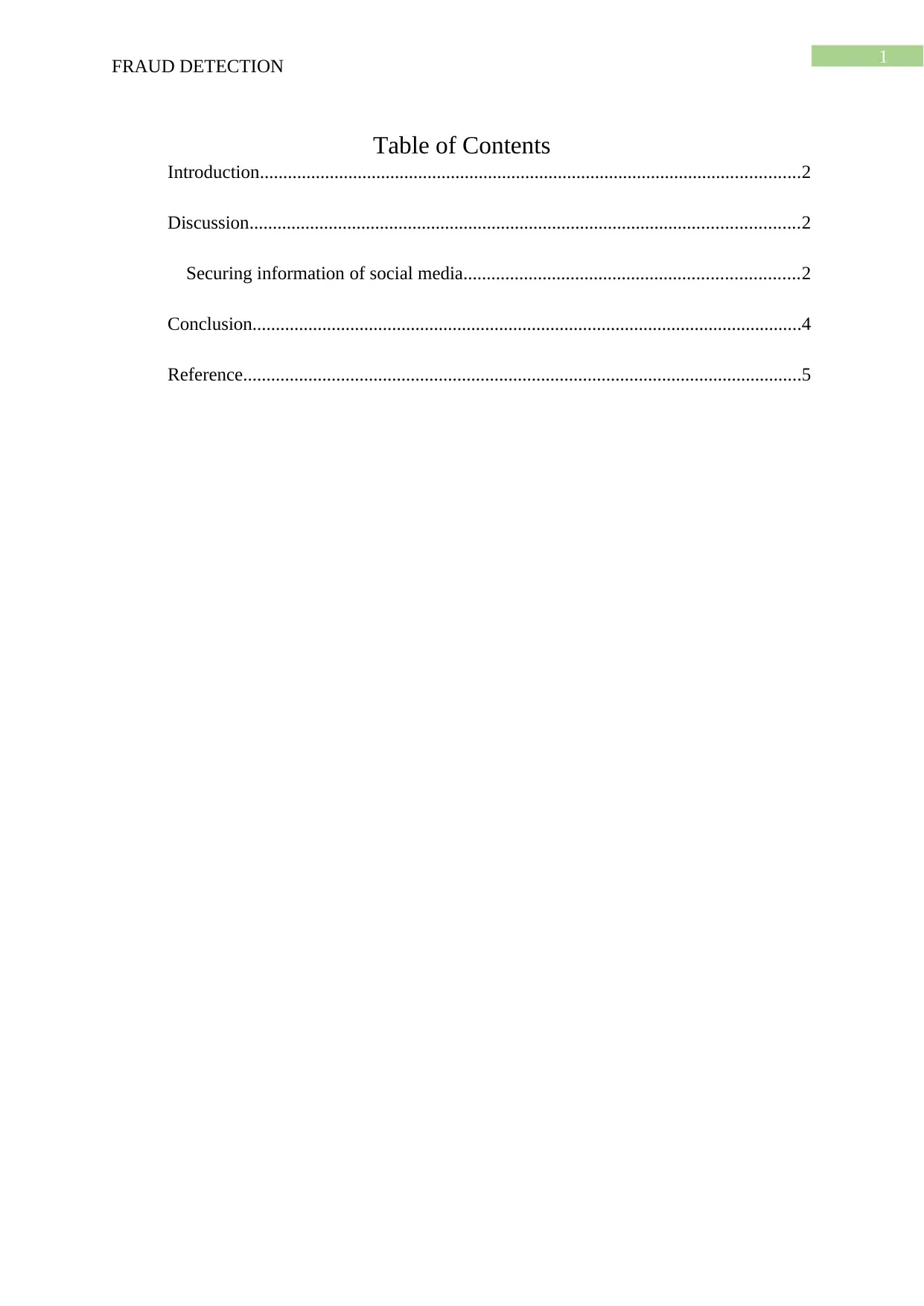
1
FRAUD DETECTION
Table of Contents
Introduction....................................................................................................................2
Discussion......................................................................................................................2
Securing information of social media........................................................................2
Conclusion......................................................................................................................4
Reference........................................................................................................................5
FRAUD DETECTION
Table of Contents
Introduction....................................................................................................................2
Discussion......................................................................................................................2
Securing information of social media........................................................................2
Conclusion......................................................................................................................4
Reference........................................................................................................................5
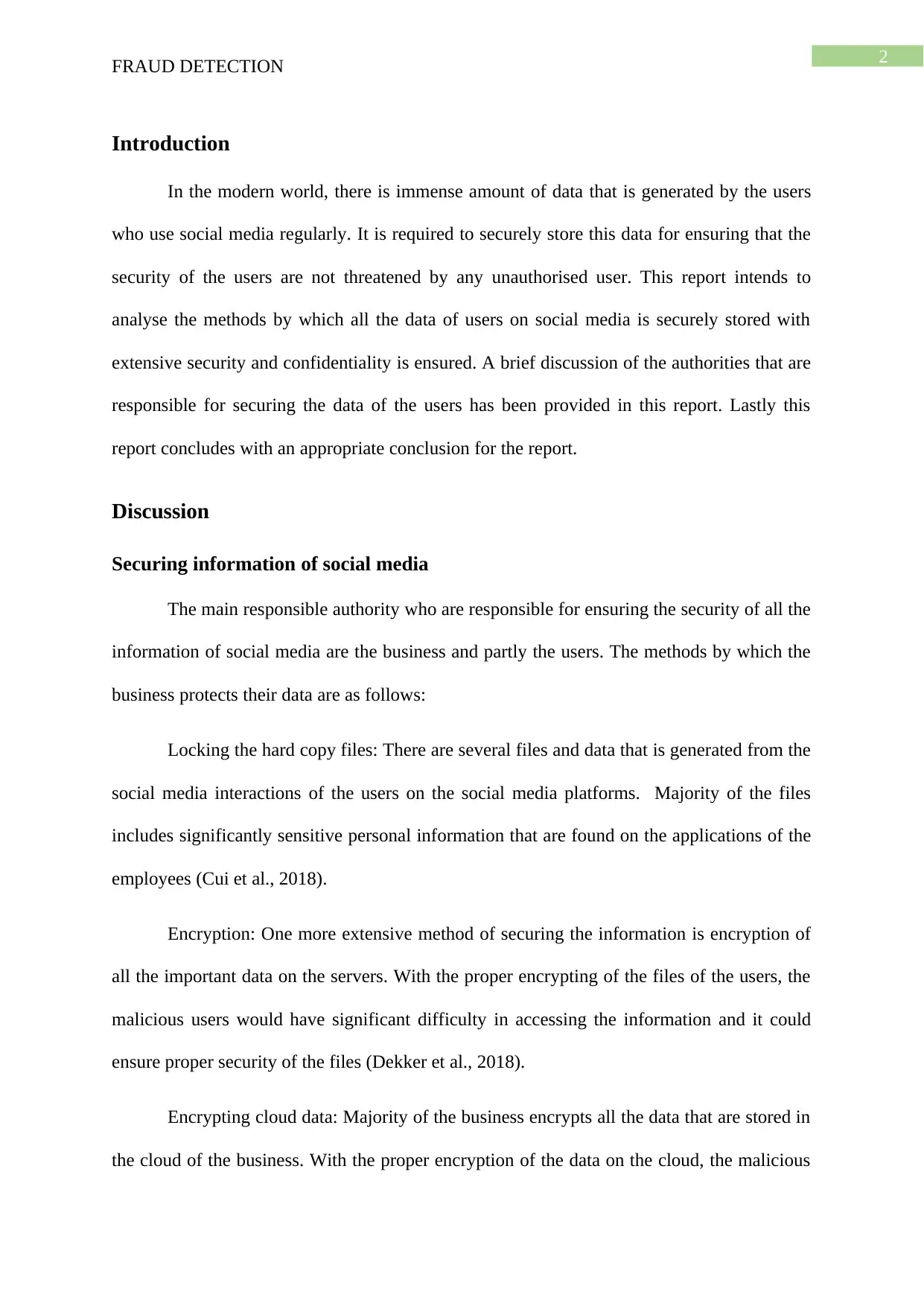
2
FRAUD DETECTION
Introduction
In the modern world, there is immense amount of data that is generated by the users
who use social media regularly. It is required to securely store this data for ensuring that the
security of the users are not threatened by any unauthorised user. This report intends to
analyse the methods by which all the data of users on social media is securely stored with
extensive security and confidentiality is ensured. A brief discussion of the authorities that are
responsible for securing the data of the users has been provided in this report. Lastly this
report concludes with an appropriate conclusion for the report.
Discussion
Securing information of social media
The main responsible authority who are responsible for ensuring the security of all the
information of social media are the business and partly the users. The methods by which the
business protects their data are as follows:
Locking the hard copy files: There are several files and data that is generated from the
social media interactions of the users on the social media platforms. Majority of the files
includes significantly sensitive personal information that are found on the applications of the
employees (Cui et al., 2018).
Encryption: One more extensive method of securing the information is encryption of
all the important data on the servers. With the proper encrypting of the files of the users, the
malicious users would have significant difficulty in accessing the information and it could
ensure proper security of the files (Dekker et al., 2018).
Encrypting cloud data: Majority of the business encrypts all the data that are stored in
the cloud of the business. With the proper encryption of the data on the cloud, the malicious
FRAUD DETECTION
Introduction
In the modern world, there is immense amount of data that is generated by the users
who use social media regularly. It is required to securely store this data for ensuring that the
security of the users are not threatened by any unauthorised user. This report intends to
analyse the methods by which all the data of users on social media is securely stored with
extensive security and confidentiality is ensured. A brief discussion of the authorities that are
responsible for securing the data of the users has been provided in this report. Lastly this
report concludes with an appropriate conclusion for the report.
Discussion
Securing information of social media
The main responsible authority who are responsible for ensuring the security of all the
information of social media are the business and partly the users. The methods by which the
business protects their data are as follows:
Locking the hard copy files: There are several files and data that is generated from the
social media interactions of the users on the social media platforms. Majority of the files
includes significantly sensitive personal information that are found on the applications of the
employees (Cui et al., 2018).
Encryption: One more extensive method of securing the information is encryption of
all the important data on the servers. With the proper encrypting of the files of the users, the
malicious users would have significant difficulty in accessing the information and it could
ensure proper security of the files (Dekker et al., 2018).
Encrypting cloud data: Majority of the business encrypts all the data that are stored in
the cloud of the business. With the proper encryption of the data on the cloud, the malicious
⊘ This is a preview!⊘
Do you want full access?
Subscribe today to unlock all pages.

Trusted by 1+ million students worldwide
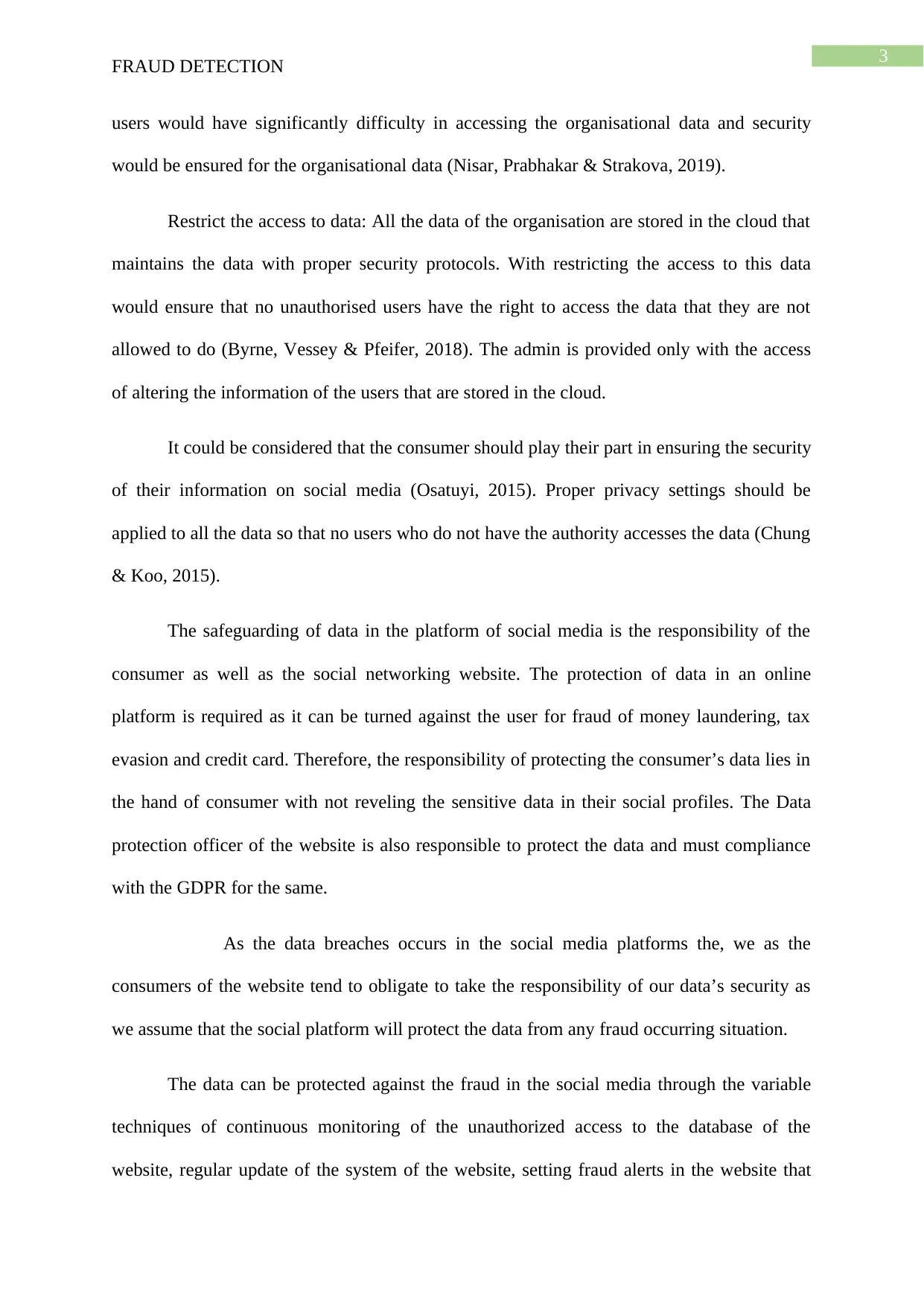
3
FRAUD DETECTION
users would have significantly difficulty in accessing the organisational data and security
would be ensured for the organisational data (Nisar, Prabhakar & Strakova, 2019).
Restrict the access to data: All the data of the organisation are stored in the cloud that
maintains the data with proper security protocols. With restricting the access to this data
would ensure that no unauthorised users have the right to access the data that they are not
allowed to do (Byrne, Vessey & Pfeifer, 2018). The admin is provided only with the access
of altering the information of the users that are stored in the cloud.
It could be considered that the consumer should play their part in ensuring the security
of their information on social media (Osatuyi, 2015). Proper privacy settings should be
applied to all the data so that no users who do not have the authority accesses the data (Chung
& Koo, 2015).
The safeguarding of data in the platform of social media is the responsibility of the
consumer as well as the social networking website. The protection of data in an online
platform is required as it can be turned against the user for fraud of money laundering, tax
evasion and credit card. Therefore, the responsibility of protecting the consumer’s data lies in
the hand of consumer with not reveling the sensitive data in their social profiles. The Data
protection officer of the website is also responsible to protect the data and must compliance
with the GDPR for the same.
As the data breaches occurs in the social media platforms the, we as the
consumers of the website tend to obligate to take the responsibility of our data’s security as
we assume that the social platform will protect the data from any fraud occurring situation.
The data can be protected against the fraud in the social media through the variable
techniques of continuous monitoring of the unauthorized access to the database of the
website, regular update of the system of the website, setting fraud alerts in the website that
FRAUD DETECTION
users would have significantly difficulty in accessing the organisational data and security
would be ensured for the organisational data (Nisar, Prabhakar & Strakova, 2019).
Restrict the access to data: All the data of the organisation are stored in the cloud that
maintains the data with proper security protocols. With restricting the access to this data
would ensure that no unauthorised users have the right to access the data that they are not
allowed to do (Byrne, Vessey & Pfeifer, 2018). The admin is provided only with the access
of altering the information of the users that are stored in the cloud.
It could be considered that the consumer should play their part in ensuring the security
of their information on social media (Osatuyi, 2015). Proper privacy settings should be
applied to all the data so that no users who do not have the authority accesses the data (Chung
& Koo, 2015).
The safeguarding of data in the platform of social media is the responsibility of the
consumer as well as the social networking website. The protection of data in an online
platform is required as it can be turned against the user for fraud of money laundering, tax
evasion and credit card. Therefore, the responsibility of protecting the consumer’s data lies in
the hand of consumer with not reveling the sensitive data in their social profiles. The Data
protection officer of the website is also responsible to protect the data and must compliance
with the GDPR for the same.
As the data breaches occurs in the social media platforms the, we as the
consumers of the website tend to obligate to take the responsibility of our data’s security as
we assume that the social platform will protect the data from any fraud occurring situation.
The data can be protected against the fraud in the social media through the variable
techniques of continuous monitoring of the unauthorized access to the database of the
website, regular update of the system of the website, setting fraud alerts in the website that
Paraphrase This Document
Need a fresh take? Get an instant paraphrase of this document with our AI Paraphraser
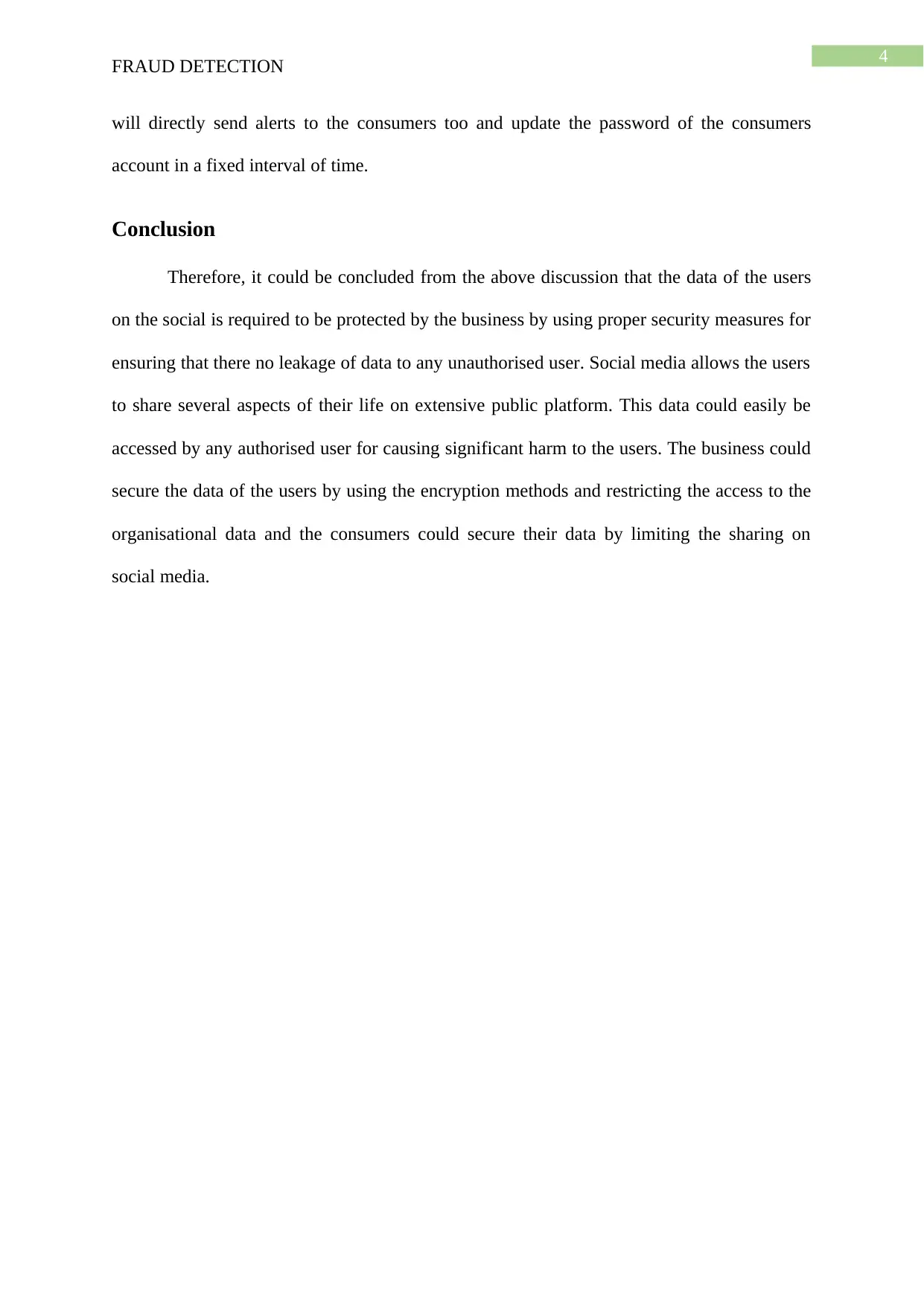
4
FRAUD DETECTION
will directly send alerts to the consumers too and update the password of the consumers
account in a fixed interval of time.
Conclusion
Therefore, it could be concluded from the above discussion that the data of the users
on the social is required to be protected by the business by using proper security measures for
ensuring that there no leakage of data to any unauthorised user. Social media allows the users
to share several aspects of their life on extensive public platform. This data could easily be
accessed by any authorised user for causing significant harm to the users. The business could
secure the data of the users by using the encryption methods and restricting the access to the
organisational data and the consumers could secure their data by limiting the sharing on
social media.
FRAUD DETECTION
will directly send alerts to the consumers too and update the password of the consumers
account in a fixed interval of time.
Conclusion
Therefore, it could be concluded from the above discussion that the data of the users
on the social is required to be protected by the business by using proper security measures for
ensuring that there no leakage of data to any unauthorised user. Social media allows the users
to share several aspects of their life on extensive public platform. This data could easily be
accessed by any authorised user for causing significant harm to the users. The business could
secure the data of the users by using the encryption methods and restricting the access to the
organisational data and the consumers could secure their data by limiting the sharing on
social media.
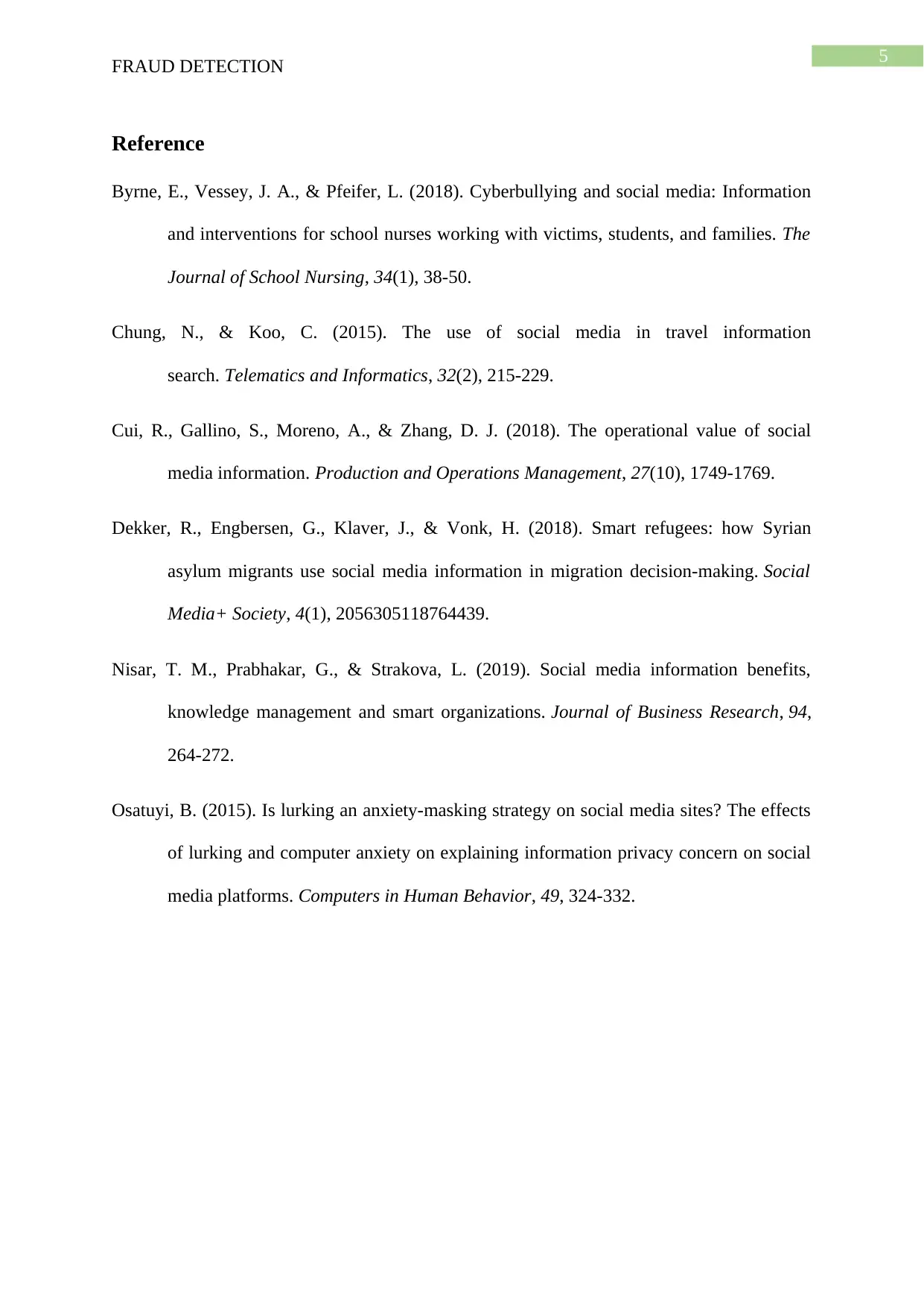
5
FRAUD DETECTION
Reference
Byrne, E., Vessey, J. A., & Pfeifer, L. (2018). Cyberbullying and social media: Information
and interventions for school nurses working with victims, students, and families. The
Journal of School Nursing, 34(1), 38-50.
Chung, N., & Koo, C. (2015). The use of social media in travel information
search. Telematics and Informatics, 32(2), 215-229.
Cui, R., Gallino, S., Moreno, A., & Zhang, D. J. (2018). The operational value of social
media information. Production and Operations Management, 27(10), 1749-1769.
Dekker, R., Engbersen, G., Klaver, J., & Vonk, H. (2018). Smart refugees: how Syrian
asylum migrants use social media information in migration decision-making. Social
Media+ Society, 4(1), 2056305118764439.
Nisar, T. M., Prabhakar, G., & Strakova, L. (2019). Social media information benefits,
knowledge management and smart organizations. Journal of Business Research, 94,
264-272.
Osatuyi, B. (2015). Is lurking an anxiety-masking strategy on social media sites? The effects
of lurking and computer anxiety on explaining information privacy concern on social
media platforms. Computers in Human Behavior, 49, 324-332.
FRAUD DETECTION
Reference
Byrne, E., Vessey, J. A., & Pfeifer, L. (2018). Cyberbullying and social media: Information
and interventions for school nurses working with victims, students, and families. The
Journal of School Nursing, 34(1), 38-50.
Chung, N., & Koo, C. (2015). The use of social media in travel information
search. Telematics and Informatics, 32(2), 215-229.
Cui, R., Gallino, S., Moreno, A., & Zhang, D. J. (2018). The operational value of social
media information. Production and Operations Management, 27(10), 1749-1769.
Dekker, R., Engbersen, G., Klaver, J., & Vonk, H. (2018). Smart refugees: how Syrian
asylum migrants use social media information in migration decision-making. Social
Media+ Society, 4(1), 2056305118764439.
Nisar, T. M., Prabhakar, G., & Strakova, L. (2019). Social media information benefits,
knowledge management and smart organizations. Journal of Business Research, 94,
264-272.
Osatuyi, B. (2015). Is lurking an anxiety-masking strategy on social media sites? The effects
of lurking and computer anxiety on explaining information privacy concern on social
media platforms. Computers in Human Behavior, 49, 324-332.
⊘ This is a preview!⊘
Do you want full access?
Subscribe today to unlock all pages.

Trusted by 1+ million students worldwide
1 out of 6
Related Documents
Your All-in-One AI-Powered Toolkit for Academic Success.
+13062052269
info@desklib.com
Available 24*7 on WhatsApp / Email
![[object Object]](/_next/static/media/star-bottom.7253800d.svg)
Unlock your academic potential
Copyright © 2020–2025 A2Z Services. All Rights Reserved. Developed and managed by ZUCOL.




